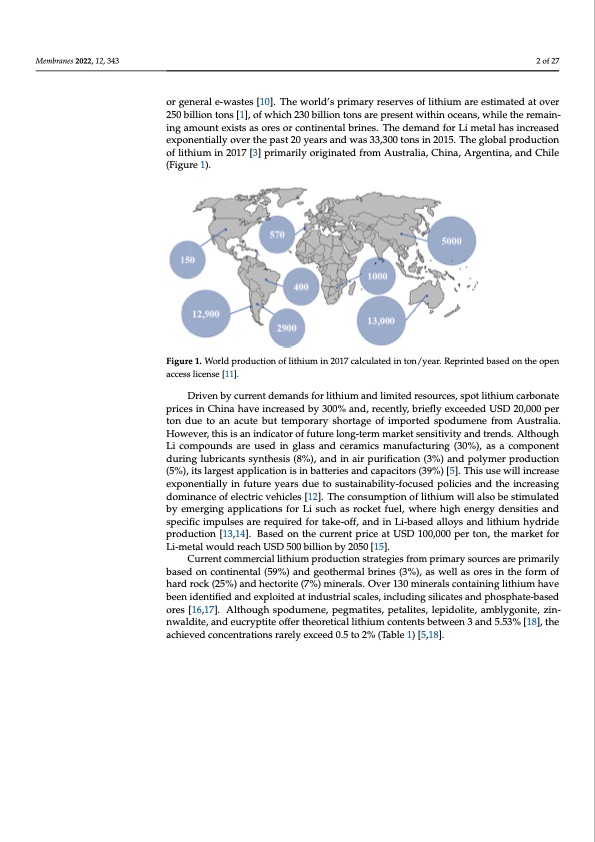
PDF Publication Title:
Text from PDF Page: 002
Memembbraranneses2200222, ,1121, ,3x43FOR PEER REVIEW 2 of 2277 o[r9]g,eonregreanler-awlaes-wteass[t1e0s][.1T0]h.eThweowrlodr’sldp’sripmriamryaryesrersverevseosfolfitlhitihuimumaraeresetsitmimataetdedaattoovveerr 250 billion tons [1], of which 230 billion tons are present within oceans, while the remain- 250 billion tons [1], of which 230 billion tons are present within oceans, while the ing amount exists as ores or continental brines. The demand for Li metal has increased remaining amount exists as ores or continental brines. The demand for Li metal has exponentially over the past 20 years and was 33,300 tons in 2015. The global production increased exponentially over the past 20 years and was 33,300 tons in 2015. The global of lithium in 2017 [3] primarily originated from Australia, China, Argentina, and Chile production of lithium in 2017 [3] primarily originated from Australia, China, Argentina, (Figure 1). and Chile (Figure 1). Figure 1. World production of lithium in 2017 calculated in ton/year. Reprinted based on the open Figure 1. World production of lithium in 2017 calculated in ton/year. Reprinted based on the open access license [11]. access license [11]. Drriviveennbbyyccurrreennttdeemaannddssffoorrlliitthhiuiumaandlliimiitteedrreessoourrcceess, ,sspoottlliitthiiumccaarrbboonnaattee pprriciceessininChhininaahhaavveeininccrreeaasseedbbyy33000%aannd,,rreecceenttlly, ,bbrrieieflfylyeexxcceeeddeeddUSSD2200,0,000ppeerr ttoonn dduuee ttoo aann aaccuuttee bbuutt tetemppoorraarryy sshhoorrttaagee ooff imimporrtteed sspodumene ffrrom Austtralliia.. Hooweevveer,r,ththisisisisaannininddicicaatotorroofffufututurreelolonngg-t-eterrmmaarrkkeettsseennssitiitvivitiytyaannddtrtreennddss. .Altlthhoouugghh LLii ccoomppoounndss aarree uusseedd iningglalasssaannddcceeraramicicssmaannuufafacctuturriningg (3(300%)), , aass aaccoomppoonneenntt ddurriing lulubbrriiccaanttss ssyynttheessiiss ((88%)),, aand iin aairirppuurrifiifcicaattioionn(3(3%))aannddppoolylymeerrpprroodduucctitoionn (5(5%)), ,itistslalarrggeessttaappplilcicaatitoionnisisininbbaatteterrieiessaannddccaappaaccitiotorrss(3(399%))[5[5].].Thhisisuusseewilillininccrreeaassee eexxpooneenttiiallly iinffuutturreeyyeeaarrssdduueetotossuusstataininaabbiliiltiyty--ffooccusseedppoolilicciieessaanndththeeininccrreeaassiningg dominance of electric vehicles [12]. The consumption of lithium will also be stimulated dominance of electric vehicles [12]. The consumption of lithium will also be stimulated by by emerging applications for Li such as rocket fuel, where high energy densities and emerging applications for Li such as rocket fuel, where high energy densities and specific specific impulses are required for take-off, and in Li-based alloys and lithium hydride impulses are required for take-off, and in Li-based alloys and lithium hydride production production [13,14]. Based on the current price at USD 100,000 per ton, the market for [13,14]. Based on the current price at USD 100,000 per ton, the market for Li-metal would Li-metal would reach USD 500 billion by 2050 [15]. reach USD 500 billion by 2050 [15]. Current commercial lithium production strategies from primary sources are primarily Current commercial lithium production strategies from primary sources are based on continental (59%) and geothermal brines (3%), as well as ores in the form of primarily based on continental (59%) and geothermal brines (3%), as well as ores in the hard rock (25%) and hectorite (7%) minerals. Over 130 minerals containing lithium have form of hard rock (25%) and hectorite (7%) minerals. Over 130 minerals containing lithium been identified and exploited at industrial scales, including silicates and phosphate-based have been identified and exploited at industrial scales, including silicates and phosphate- ores [16,17]. Although spodumene, pegmatites, petalites, lepidolite, amblygonite, zin- based ores [16,17]. Although spodumene, pegmatites, petalites, lepidolite, amblygonite, nwaldite, and eucryptite offer theoretical lithium contents between 3 and 5.53% [18], the zinnwaldite, and eucryptite offer theoretical lithium contents between 3 and 5.53% [18], achieved concentrations rarely exceed 0.5 to 2% (Table 1) [5,18]. the achieved concentrations rarely exceed 0.5 to 2% (Table 1) [5,18]. Table 1. Chemical composition with the percentage of lithium in minerals [16,17]. Minerals Spodumene Petalite Lepidolite Amblygonite Eucryptite Abnormalite Percentage of Lithium (wt%) LiAlS2O6 3.73 LiAlSi4O10 2.27 LiKAl2F2Si3O9 3.56 LiAlFPO4 4.74 LiAlSiO4 5.53 LiCO3 18.75 Chemical FormulaPDF Image | Electro-Driven Materials and Processes for Lithium

PDF Search Title:
Electro-Driven Materials and Processes for LithiumOriginal File Name Searched:
membranes-12-00343-v3.pdfDIY PDF Search: Google It | Yahoo | Bing
Product and Development Focus for Infinity Turbine
ORC Waste Heat Turbine and ORC System Build Plans: All turbine plans are $10,000 each. This allows you to build a system and then consider licensing for production after you have completed and tested a unit.Redox Flow Battery Technology: With the advent of the new USA tax credits for producing and selling batteries ($35/kW) we are focussing on a simple flow battery using shipping containers as the modular electrolyte storage units with tax credits up to $140,000 per system. Our main focus is on the salt battery. This battery can be used for both thermal and electrical storage applications. We call it the Cogeneration Battery or Cogen Battery. One project is converting salt (brine) based water conditioners to simultaneously produce power. In addition, there are many opportunities to extract Lithium from brine (salt lakes, groundwater, and producer water).Salt water or brine are huge sources for lithium. Most of the worlds lithium is acquired from a brine source. It's even in seawater in a low concentration. Brine is also a byproduct of huge powerplants, which can now use that as an electrolyte and a huge flow battery (which allows storage at the source).We welcome any business and equipment inquiries, as well as licensing our turbines for manufacturing.| CONTACT TEL: 608-238-6001 Email: greg@infinityturbine.com | RSS | AMP |